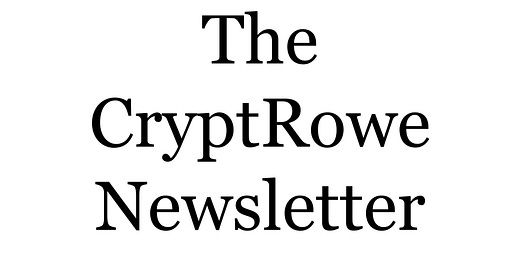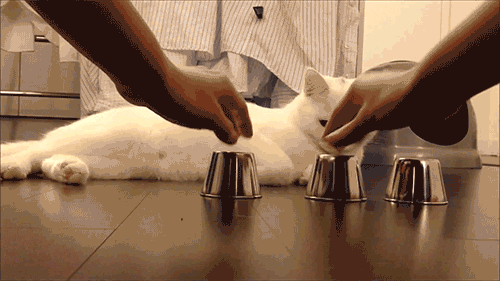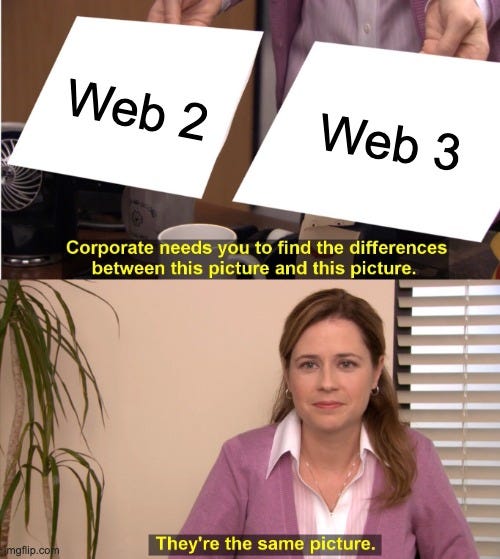The CryptRowe Newsletter provides Math, Stats, and Data insight around the current state of Bitcoin and other Digital Assets. Whether you’re new to Crypto, have some experience, or are a seasoned investor or institutional fund manager, this newsletter is for you.
This is an Essay (not the regular bi-weekly Forecast) from the CryptRowe Newsletter. The Forecasts (and occasional Essay’s) can be found by clicking the link above or Subscribing below 🎉.
Caveat
This email will most likely cut off / won’t fit into most inboxes. So this is a reminder to click the “read more” at the bottom, or just click the title at the top of the email to be taken to the Newsletter webpage.
On we go 😏 🎉.
TLDR;
5 Key Questions to Help You Navigate Web3 & DeFi
Who’s involved, and what kind of power do they have?
Where are the Dollars ($, USD)?
Where’s the token supply?
Could this just be a database?
Is this unique? Could I just spin one up myself?
Intro
A few months ago I got a text from a friend I hadn’t heard from in a while (we’ll call him Jack). Jack told me he didn’t know much about Bitcoin or Crypto, but he had seen a website that was offering 18% interest on cash deposits (USD-$).
Jack asked me, “Is this legit? This feels too good to be true.”
I sighed.
“It feels too good to be true because it is,” I said. “Here, I’ll explain…”
I went on to tell Jack what I'm going to share with you now.
There's too many dangers out there in the crypto ecosystem to not have a framework that you use to analyze whether a project is a good investment or not. This can be one of your frameworks 🙃.
We don’t need to look hard to find examples of why we need to be vigilant and savvy in this space.
The LUNA DeFi (Algorithmic Stablecoin) catastrophe wiped out billions of dollars from investors.
“Rug Pulls” are common in the NFT space (there’s a team devoted to finding them)1
Exchanges promote risky fluff assets to retail traders.
People in this space are launching and promoting new Crypto, DeFi, and Web3 projects2 every day it seems. Some are well intentioned and well designed (with your best interest in mind) yes. Of course.
However, that’s not the scope of this essay. It seems like the vast majority of projects are more interested in building something to take your money and use you as their exit liquidity.
And I don’t want that to happen to me. I don’t want that to happen to you. I don’t want that to happen to anyone.
So, together, let’s walk through some questions that can help us identify whether a project is “risky” (at best) or “nefarious” (at worst) so that we can keep our cash safe and invest with higher degrees of discernment, expertise, and confidence.
Question #1: “Who’s involved, and what kind of power do they have?”
So because it's the Internet and because crypto people love that you can have anonymity, sometimes (especially in their projects), they like to hide behind that. Which is fine.
However, if you're going to be putting your hard earned money into a project, you need to know who is involved. (And I'm not necessarily talking about identity revelation.) I’m talking about: Who’s in charge? Who has the power? And who does this project benefit and why? (Qui Bono)
And there's lots of kinds of people that can be involved in crypto projects and the scope of power and influence for them can be really varied.
For example: Who is building the project? What are their incentives (intrinsic and extrinsic)? Why?
Regarding governance: Who has the power to change the application? Who gets to decide smart contract alterations or protocol changes? Broader app changes? Who (if anyone) gets to alter transactions taken place within their system? Why?
(*deftly sidesteps conversation on definition of “Decentralized”*)
Who gets to alter or distribute token supply? Why?
A Web3 project where the smart contracts can be modified too much or too easily, or a Web3 project where the incentives of those in control go against the benefits of the user are both red flags we are looking for here.
And finally regarding investors: Who are the investors? Who funded this? Is the project still actively recruiting investors? Does the project have a stable capital backing? Do they require more investors to keep the project functioning? What kind of return are the investors expecting?
If you’re being “given” 20% yield, where is that 20% coming from? Most likely investors of some sort. How are they expecting to get their investment back? (Hint: it’s most likely off of you 😬🤦🏼♂️.)
And for everyone involved (even holders or retail users): How are the people involved in this project (builders, holders, investors, etc.) talking about the project? Anyone saying, “Hold or you’re an idiot” is shilling you their coin, or “talking their bag” as they say (because it benefits them).
Don’t let anyone shame you into a bad business decision for your personal finances.
Another thing to be on the lookout for is project leaders who are flashing the money they are making and talking about “going to the moon” or “lambos” too much. While fun, these folks aren’t in it for “the project” most likely ¯\_(ツ)_/¯.
These types of questions should be the first you ask in any project and it shouldn't be a mystery. It shouldn't be hard to find out this information. Who's involved, how they’re incentivized, and the scope of their involvement should be really obvious.
If it’s not, that’s a red flag.
Question #2: “Where are the Dollars ($, USD)?”
This question feels like it cuts at the heart of, almost, the entire issue. If we were at a carnival or a fair and someone was playing a shell game, this question feels like an x-ray vision for that.3
This question is really important because a lot of the DeFi apps that promise 20% yields or more, do so because (spoiler alert) they're not giving you 20% yields in dollars.
You give them your dollars, and they will give you 20% yields… except in their (proprietary) currency.
This is part of the reason why DeFi projects are so prevalent: they are so easy to do. You or I could start one relatively easily. As an example, let’s say I launch a token and DeFi application. We’ll call the new cryptocurrency / token I made up “Matt Bucks”. (Gif below is best “Monopoly Money” Gif I could find 😂.)
The DeFi protocol / app I build tells you to give me $1000 and I will give you 1000 Matt Bucks (MB’s) every two weeks. Now, I have an unlimited (or crazy large) supply of Matt Bucks to give you but I'm gonna take your dollars and do whatever I want with them: reinvest in the app; pay back my investors; pay myself, etc. And again, I’m going to do all of that in USD $.
But… I'm going to pay you in Matt Bucks.
Now this all works fine if one MB equals one USD $ (or more) forever, but that's not how it works. These coins and tokens are tied to the free market. And the crypto free market is volatile as fuck. And usually there’s a common theme or trend to these coin valuations (especially against Bitcoin) over time. It’s not great (i.e. it drops in price pretty consistently overtime).
So essentially you're giving me your dollars and I'm taking them and I'm happy and I'm paying myself and my investors and I'm giving you Matt Bucks! Great for me, not great for you. So when the price of Matt Bucks drops you're screwed. And everyone who owns MB’s is just hoping that the price will go back up. But that's not how it works usually.
(Also note: for Stablecoin based Web3 projects, if the project can’t show you how your dollars are being used or collateralized, this is a red flag.)
Basically, if your dollars are being used in a way that benefits the project that would be a green flag. It’s when your dollars are being used to sustain an unsustainable model and mostly pay back VC’s or Investors that it’s a big ol’ red flag.
So protect your dollars. Watch how dollars are being used in the project. And if you are going to invest in DeFi projects, be careful about what you’re actually getting in return for loaning or investing your USD $’s.
The only time it really makes sense to invest in a DeFi app is if you can add or remove liquidity without any delays or waiting periods and if you're absolutely certain that the price is going to go up. And then when the price goes up you take out your earnings and principle and you sell.
Even that feels risky and like a racket though. So if that doesn’t sound appealing or you can’t be utterly confident in upwards returns: best to probably stay away.
Question #3: “Where’s the token supply?”
Another friend of mine (not Jack, we’ll call this friend Susan) messaged me one day and said that their friend had started a new cryptocurrency. I said “Very cool!” And then Susan said that she had invested $10,000 with this friend.
Fml 🤦🏼♂️.
She asked if I would look into the coin. I did. It was a basic coin on Ethereum that someone had launched. It had a crazy high token supply, and most of the supply was concentrated in the hands of the founder.
Again, these kinds of coins and projects are so (relatively) easy to launch, anyone can do them. You can make up a currency or Matt Bucks from nothing. That's what this person did and that's the tokens/cryptocurrency that Susan had bought.

Now lucky for Susan, the token price had gone up 3X. I still told her, “Susan, for the love of God: Sell! Get your money back (and some) and get out this. It’s not going to last.”
She didn't listen to me for weeks.
Then the token price went up another 2X.
I still told her the same thing, “Get out!!”
She finally listen to me and cashed out.
Weeks later the token price crashed 95%.
She still messages me from time to time to thank me for telling her to sell and helping her sell.
Stories like this are really common in the DeFi or crypto space because it's relatively easy to spin up a new cryptocurrency or even DeFi app. Except usually, not everyone is as lucky as Susan.
So everyone can make a new Web3 project and everyone wants to do it.
But why?
Well, because everyone wants to make money. Everyone wants to take your dollars and give you their version of Matt Bucks.
What's really interesting is, especially in DeFi, is that often, the projects will use their token to even incentivize or pay their own staff or investors. Again taking dollars and giving Matt Bucks in return (that are subject to the free economy and of which most of the supply are held by the team, staff, friends, or investors.)
And all those investors and friends and people close to the project (*cough* Cantilon Effect *cough*) are waiting for you to exchange your dollars for their token so that they can get rich.
So, a project should readily list and it should be easy to see where the token supply is. Who owns how much of the token? How much of the supply is released? How much will be released? When? Why? Can the supply be changed? Is the supply inflationary? Deflationary? Why? Who got supply of the token right away? Why? Where is it? How are tokens given to contributors to the project?
If the majority of the supply is controlled by a handful of entities this is a red flag. If those entities happen to be the creators of the web3 project this is an even bigger red flag.
All of this should be transparently available and easy to find and audit.
If it’s not, you guessed it: Red Flag.
Question #4: “Could this just be a database?”
Now, I know that when you see the word database, if you're not super technical, you might be intimidated or a little scared. So I'll try to keep the techie language to a minimum.
But to oversimplify, the majority of DeFi projects probably don't need to use Blockchain technology.
There I said it. *Ducks*
So many Blockchain technologies (or Web3 as they like to be called) are just Web2 projects that use a Blockchain because it's hip and popular.
*Ducks again*
And they use a Blockchain as if it was a regular software stack. You could easily replace most DeFi project’s Blockchain use with a database and servers with an open API. And sure if you wanted to have a currency that you released on a Blockchain, fine.
*Deftly, yet again, sidesteps the discussion about "is a non-peer to peer blockchain even beneficial or useful? Could it even be called a valid Blockchain use? And chuckles to himself at his clever deflection as he moonwalks away.*
So in general, I'm skeptical of so many projects in the space because so many could be replaced by a regular database or API. They are just jumping on the hope-train of Blockchain and trying to make money.
I don't blame them. I mean I kind of do. But I more want you to be aware that using the word Blockchain does not mean the project is innovative or that you're somehow going to magically make 20% yield.
If we do get to a point where a project using a blockchain has a valid use case (tool solves the problem, not the tool being used in search of a problem to solve), then we have to ask questions like: OK so it is this even a viable business model? Is this yield being offered sustainable from the app or functionality design?
We have to ask actual product market fit questions: vibes and hype business models will not be sustainable.
Basically, if there is no advantage in using a blockchain network for the project then this is a red flag. If the project is a network but is controlled by a handful of entities this is also a red flag. If the Web3 project cannot articulate the benefits/tradeoffs of using a blockchain network this is a red flag.
If a Blockchain project could be replaced with a database and and a regular tech stack, then why are they doing it?
“Just to make money” is my bet.
And if that’s the case… stay away.
Question #5: “Is this unique? Could I just spin one up myself?”
So I have alluded to this in the questions above but I think this question is important enough that it needs to be its own section. Now, I know not everyone is super tech savvy, but this question is super important. Could we just spin one up ourselves? Could we invent our own DeFi application or cryptocurrency?
The answer is: absolutely yes.
Now, a necessary related question is: of those DeFi apps or cryptocurrencies that have been spun up or created, which have the most staying power?
Besides Bitcoin (who’s peer-to-peer network effects have little chance of being replicated and are thus a reason for it’s staying power), which tokens or projects have solid fundamental design? Have solid answers to the questions above? And have high adoption and high involvement (and thus higher odds of staying power)? We can replicate design and project look and feel, but we can't replicate the trust and involvement and activity that's been developed by long running projects over time.
So if these kinds of projects and efforts are easily replicatable, and we do want to be involved in this ecosystem, we will want to look for the projects and coins that have the most adoption and staying power.
Not your friend or some shady group of people that made one just so that they can get a piece of the pie and a piece of your dollars.
Closing
There are folks who write about this topic in more depth and insight that I do. Here’s two articles I would recommend reading if this essay piqued your interest.
I hope you learned something about DeFi and Web3. I hope you're able to take away these questions and use them as you navigate the digital asset world. I hope you explore. I hope you build. (🎵 I hope you dance. 🎵 😂) I hope you question. I hope you embrace nuance.
And most importantly, I hope you protect your cash and capital.
Until next time,
Matt Rowe
Thank You
I wanted to say thank you to Ecoinometrics, T / Data Always, and 0xDewey who read over a rough draft of this Essay and gave some great feedback, constructive criticism, and enlightening discussion over the contents.
Thank you all for your insight, wisdom, and kindness!
Links and References
Data Provider: Glassnode (free on-chain charts, paid tiers available, I have T3).
My Twitter: @mattrowsboats (often provides on-chain analysis)
Crypto Learning Twitter Lists: On-Chain, Macro-Econ, and TA.
Disclaimer 1
Exercise caution, don’t lose it all. Please don’t trade on this newsletter assuming it is perfect information. Everything here is probabilistic and based off of past patterns, which may prove to be invalidated. Short time frames are subject to less accuracy as markets can change on a dime due to a variety of factors and events in the world. Use risk management as much as possible.
Disclaimer 2 (the all caps one)
THE CRYPTROWE NEWSLETTER DOES NOT MAKE ANY EXPRESS OR IMPLIED WARRANTIES, REPRESENTATIONS OR ENDORSEMENTS WHATSOEVER WITH REGARD TO THE REPORT/BLOG. IN PARTICULAR, YOU AGREE THAT THE CRYPTROWE NEWSLETTER ASSUMES NO WARRANTY FOR THE CORRECTNESS, ACCURACY AND COMPLETENESS OF THE REPORT/BLOG.
YOU ARE SOLELY RESPONSIBLE FOR YOUR OWN INVESTMENT DECISIONS. WE ARE NEITHER LIABLE NOR RESPONSIBLE FOR ANY INJURY, LOSSES OR DAMAGES ARISING IN CONNECTION WITH ANY INVESTMENT DECISION TAKEN OR MADE BY YOU BASED ON INFORMATION WE PROVIDE. NOTHING CONTAINED IN THE REPORT/BLOG SHALL CONSTITUTE ANY TYPE OF INVESTMENT ADVICE OR RECOMMENDATION (I.E., RECOMMENDATIONS AS TO WHETHER OR NOT TO “BUY”, “SELL”, “HOLD”, OR TO ENTER OR NOT TO ENTER INTO ANY OTHER TRANSACTION INVOLVING ANY CRYPTOCURRENCY). ALL INFORMATION PROVIDED BY THE CRYPTROWE NEWSLETTER IS IMPERSONAL AND NOT TAILORED TO YOUR NEEDS.
BY USING THIS REPORT/BLOG, YOU ACKNOWLEDGE THESE DISCLAIMERS.
A friend of mine who builds in the NFT space’s org recently partnered with them.
In this piece, I use DeFi and Web3 interchangeably. I know they aren’t the exact same, yes. For more on the ideal vision of Web3 and the Owner Economy I was recommended to read this (I haven’t yet) but thought I’d share here anyways.
I use USD $ Dollars in this example and throughout this article. The same thoughts apply to any base currency though, of course (non-US centric).










